As the name suggests, the lemon basil brings with it a pleasant lemon aroma. It is therefore ideal for preparing refreshing drinks or tasty dishes.
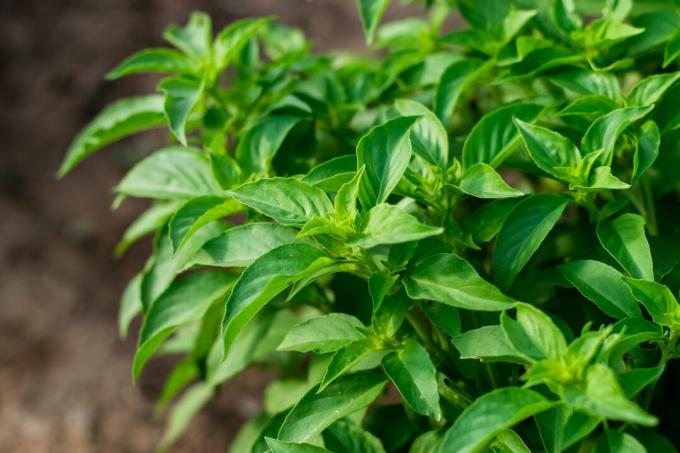
Whether in the bed, on the balcony or the windowsill: the cultivation of lemon basil (Ocimum americanum) is possible for everyone and not very complicated. Not only because of the taste, but also because of the healthy ingredients, the aromatic herb is a real enrichment in the kitchen. In this article you will learn how to sow and care for lemon basil and how to use it.
contents
- Lemon basil: origin and properties
- The best varieties
- Location and sowing of lemon basil
- The right care
- Is Lemon Basil Hardy?
- Harvesting and Using Lemon Basil
Lemon basil: origin and properties
Lemon basil is also known as American basil and belongs to the mint family (Lamiaceae). The herb has its origins in India and other areas of tropical latitudes, such as in certain countries in Asia, Africa and South America. The high heat requirement of lemon basil can be derived from the countries of origin.
The growth habit of the annual herb is bushy, branched with upright shoots that reach a height of up to 40 cm. Long hairs can occasionally be seen on the petioles, undersides of leaves and flower buds of this species.
The leaves of the mint family are slightly smaller than those of the well-known Genovese basil (Ocimum basilicum ˈGenoveseˈ). They are also narrower in shape, tapering to a point and their edges are slightly serrated. In contrast to the classic basil types and varieties, the leaves are not blistered at the top.
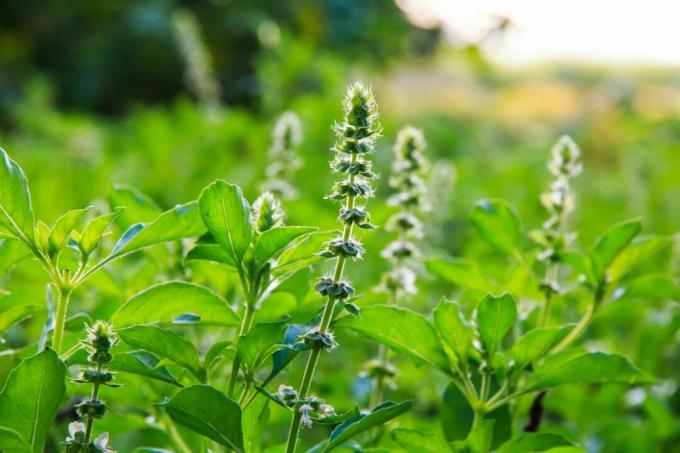
The hermaphroditic, mirror-symmetrical lip-shaped flowers of the lemon basil are pale purple to white in color, appear from June to September and are on an unbranched inflorescence. Due to the low pollen value and medium nectar value, they are not of great importance to bees and other insects. Later, black seeds with a smooth surface, about 1.5 to 2 mm in size, form.
Is Lemon Basil Perennial? Lemon basil is not perennial, as the herb goes through the generative phase in the first year, i.e. it flowers and produces seeds. The plant eventually dies towards the end of the year.
The best varieties
Below we present different varieties of lemon basil. You can also find more variety of flavors and smells in our article on the basil varieties discover.
- Ocimum americanum ˈType Limeˈ: The growth height of this variety with flowers is 40 cm. Their characteristics are identical to those of the species.
- Ocimum americanum ˈSweet Lemonˈ: The growth of this variant is rather compact and bushy with a height of 15 - 30 cm. It is therefore ideal for the balcony or pot planting in general.
- Ocimum americanum ˈLemonetteˈ: The "Lemonette" variety grows to a height of around 25 - 30 cm and otherwise hardly differs from the species.
- ocimum x africanum (Syn. Ocimum americanum var. pile): This so-called lemon basil is a hybrid of Ocimum americanum and Ocimum basilicum. It reaches a height of about 30 cm and also has the intense lemony aroma.
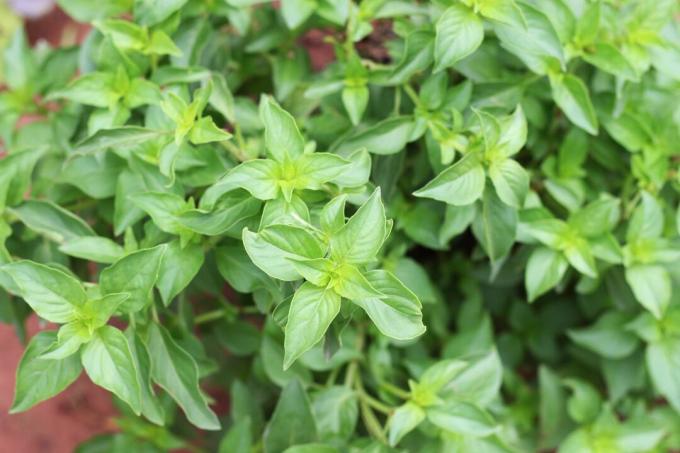
Location and sowing of lemon basil
The location of the lemon basil should definitely be sunny, warm and sheltered from the wind. The tropical spice plant may only be placed outdoors when the temperatures no longer fall below 10 °C. A permeable, humus-rich soil with sufficient nutrients and moisture provides the optimal basis for the lemon basil, which needs warmth.
It is also very suitable for cultivation in pots with a capacity of around 8 to 10 liters. These should have a drainage option for excess irrigation water and ideally also be equipped with a drainage layer made of expanded clay at the bottom of the pot. A high-quality potting soil such as ours can be used for filling Plantura organic universal soil be used. This is good for the mint family, as lemon basil requires more nutrients than most other herbs. The fertilizer and quality compost that are already included ensure that the plant's basic needs are well taken care of.

Plantura organic universal soil
Organic, peat-free & climate-friendly:
For all plants indoors & outdoors,
100% natural ingredients,
harmless to humans and animals
The herb could also be sown directly outdoors or in a greenhouse from around mid-May. However, the germination time can then be a little longer as long as there is no optimal germination temperature. It also pushes back the start of harvest. By pre-cultivating indoors, you can harvest earlier and make optimal use of the cultivation period. We have explained step by step how to grow your own lemon basil from seeds yourself:
- The time of sowing indoors is from mid-March
- Fill the pots with potting soil
- Just press the seeds as they are around light germinator acts
- Multiple seeds per pot produce bushier plants
- Keep the substrate constantly moist
- Place the pots in a warm, bright place
- The germination temperature is 18 – 25 °C
- A germination period of 10 - 15 days is to be expected
- From a height of 5 - 10 cm, the young plants are placed in a larger pot with a more nutrient-rich substrate
- Only bring your lemon basil outside when the temperature no longer drops below 10°C
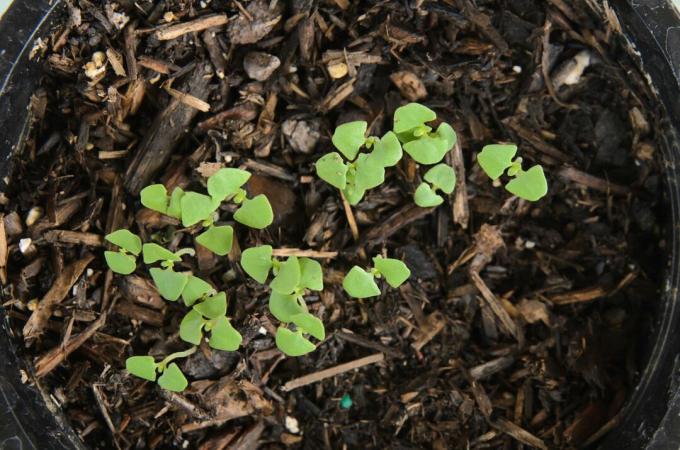
The right care
The care of the lemon basil is not very complex. However, there are a few things that should be checked regularly.
As far as the water supply is concerned, the soil or substrate in the pot should always be slightly damp. In addition to dryness, however, there must be no waterlogging. When the top layer of soil has dried, a little more is poured in again.
During the growth phase, the lemon basil is fed every 1 to 2 weeks with an organic liquid fertilizer like ours Plantura Organic Tomato & Vegetable Fertilizer provided. In liquid form, this can simply be mixed with the irrigation water.
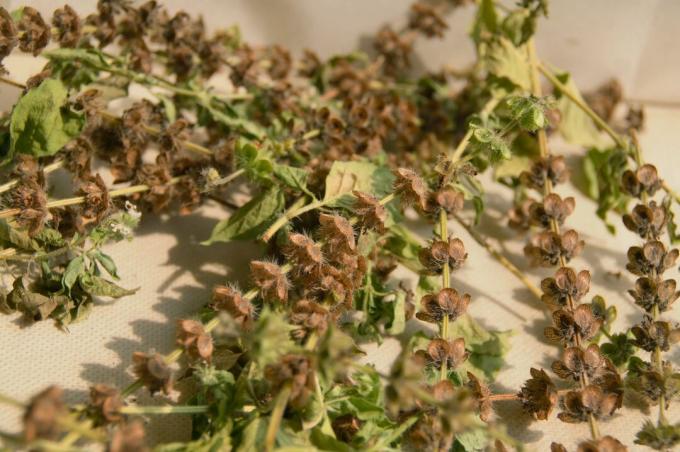
Even the regular harvesting of the herb is a care measure, as it stimulates the growth and branching of the mint family and prevents premature flowering.
Is Lemon Basil Hardy?
The lemon basil is clearly not to be classified as winter hardy - the plant largely stops growing at temperatures of around 12 °C and below. However, since it is an annual herb anyway, winter hardiness doesn't really matter. In order to extend the harvest period or to let the seeds finally ripen, it pays to put the lemon basil in the pot indoors from autumn. The place should have sufficient light and warmth.
Harvesting and Using Lemon Basil
When harvesting the lemon basil, the whole shoot tips are always snapped off, instead of just individual leaves. This promotes branching of the plant and delays flowering. Because the flowers affect the growth and flavor of lemon basil, they should be removed unless you intend to harvest seeds later. In fact, not only the leaves but also the flowers of lemon basil are edible. However, since these offer a rather bitter taste experience, they are primarily used to decorate dishes. As for the taste of the leaves, the typical basil aroma is complemented by the fruity, intense lemon aroma.

The leaves of the lemon basil are ideal for use in fish dishes, exotic rice dishes, but also in desserts and sweets. In order to preserve as much of the refreshing aroma as possible, the leaves should be used freshly harvested. When preparing hot food, add it towards the end so as not to overheat it.
But the kitchen herb is not only ideal for use in cooking - drinks can also be used very well spice it up well: a soothing tea made from lemon basil, refreshing cocktails or sparkling lemonade. Even a lemon basil syrup can be made from it.
Unfortunately, drying the lemon basil does not make sense to preserve it, as a large part of the aroma is lost in the process. For example, preparing a herbal oil, freezing the leaves or making a lemon basil pesto are better suited.
If you have already bought a potted basil from the supermarket and are now having difficulties To keep the plant alive, we have the right advice: In our special article, we reveal how man Pick up the basil can.
...and receive concentrated plant knowledge and inspiration directly in your e-mail inbox every Sunday!

